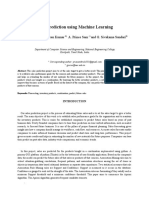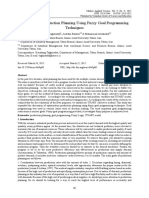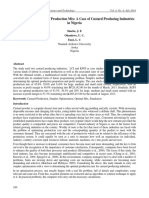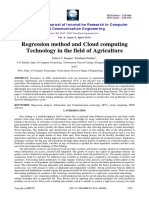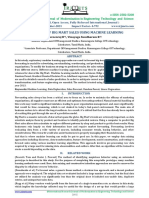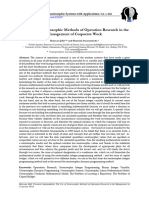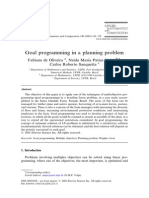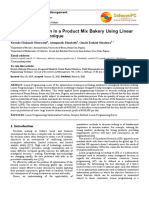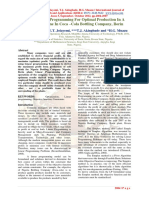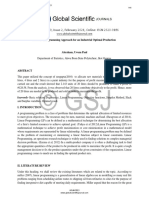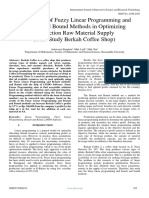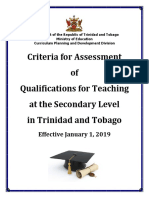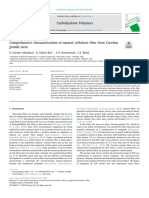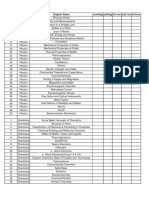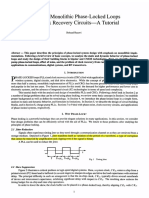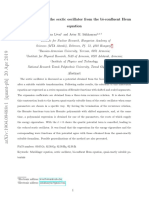Optimize Tea Production with Goal Programming
Optimize Tea Production with Goal Programming
Volume 9, Issue 11, November – 2024 International Journal of Innovative Science and Research Technology
ISSN No:-2456-2165
Optimize the Tea Production of Dunkeld
Tea Factory Using Goal Programming Approach
P. S. Sudharshini
Nawaloka College of Higher Studies, Colombo Sri Lanka
Abstract:- Tea production is one of the main income much of this use is due to a book by Sang Lee entitled “Goal
resources of Sri Lanka. There are 896 tea estates situated Programming for Decision Analysis” and computer
in Sri Lanka. Dunkeld tea estate located in Nuwara Eliya programs developed by Lee and Jaaskelainen.
district, which has 21 tea estates in total. In this study a
step has been taken to develop a mathematical model to Linear programming is a mathematical method for
optimize the tea production of Dunkeld tea estate. A brief maximizing profit or minimizing cost subject to certain
introduction to Goal Programming given in the model. constraints or limitations. The concept of goal programming
The mathematical model mainly targeted profit, is different from linear programming, here deviation
expenditure, production and supply. All the expected between goals and targets to be achieved with given
values were decided by the factory management. This limitations are minimized. These deviations are known as
model can be applied for other industries which have slack variables.
similar environmental situations.
The general Goal Programming model can be
Keywords:- Optimization, Tea Estates, Goal Programming, expressed as
Mathematical Model, Sri Lanka, Production.
𝑀𝑖𝑛𝑍 = 𝑑 − + 𝑑 +
I. INTRODUCTION
Subject to:
Sri Lanka, formerly known as Ceylon, is an island
65,610sq.km situated four degrees north of the equator; 𝑓(𝑥) + 𝑑 − + 𝑑 + = 𝑔𝑖
ascend from level to approximately 2400 meters above the
sea level. 𝑛
∑ 𝑎𝑖𝑗 × 𝑥𝑗 ≤ 𝑏𝑖 , 𝑖 = 1,2, … … , 𝑚
Dunkeld is a tea estate situated in Hatton a major 𝑗=1
commercial city involved in tea production in upcountry of
Sri Lanka approximately 1301 meters above the sea level. 𝑥𝑗 ≥ 0, 𝑑 − ≥ 0, 𝑑 + ≥ 0
When we recap the recent history of the Dunkeld estate it
was owned by Chandana William in 2008 and the ownership Here 𝑔𝑖 is the goal which is expected from the objective
changed in 2009 to Muthusamy who is the owner of functions.
Harrington Organic Tea Estate, Dambulla. Under the new
management Dunkeld faced heavy losses due to the increase 𝑓(𝑥) = ∑𝑛𝑗=1 𝑐𝑗 𝑥𝑗 to achieve as closely as possible
in cost. Muthusamy then sold 51% of the Dunkeld Tea Estate subject to the given constraints.
shares to Dilmah one of the market leaders in tea business.
At present field expenses are borne by Muthusamy and III. LITERATURE REVIEW
whereas the factory sector expenses are borne by Dilmah. As
per sources there are 8 brokers buying the tea produced at Application of goal programming was studied by
Dunkeld Tea Factory. different researchers. Banashri Sinha and Nabendu Sen
developed a mathematical model using goal programming to
II. OVERVIEW OF GOAL PROGRAMMING optimize the tea production of tea industry of Barak Valley
of Assam. Moreover, Suresh Chand Sharma, Devendra
Goal programming was introduced in 1961 by Charnes Singh Hade, Sanjay Kumar Bansal and Shilpa Bafna
and Cooper. In 1965 Ijiri brought it to a usable point, formulated a goal programming model to optimize the
employing a generalized inverse technique to obtain environmental risk production in dairy production system. In
solutions. In 1968. the other hand some researchers developed model using the
concept mixed goal programming. Thierauf et al developed
Contini considered Goal Programming under a mixed goal programming model to optimize the production
conditions of uncertainty, while in the same year planning. Similar concept followed by M. E. Nja and G. A.
Jaaskelainen applied it to aggregate production planning. Udofia in flour producing companies. Some researchers used
More recently, Goal Programming can be applied in other this concept in various industries. Vivekandan et al came up
areas, including industries, financial, academic, media etc.
IJISRT24NOV1511 www.ijisrt.com 2537
Volume 9, Issue 11, November – 2024 International Journal of Innovative Science and Research Technology
ISSN No:-2456-2165
with a model to analyze the cropping pattern of a certain Source of Data
region. Monthly wise data from January 2013 to December
2014 collected from Dunkeld tea factory are used for this
Objectives of the Study study.
The management of Dunkeld tea factory mainly
targeted a better return; at the same time, they restricted IV. METHODOLOGY
some resources. In this study profit, expenditure, production
and supply are decided to be the main objective. Meanwhile A. Normality Test
production area, inventory space, financial commitment and Some statistical procedures are heavily dependent on
human and physical resources are restricted by factory the assumption of normality, and in case, one can verify that
management. Considering the above expectations and this assumption is questionable. These procedures should be
limitations, a mathematical model which can meet the avoided. It is therefore useful to have techniques available
objectives is desired to be developed in a gainful way for the that can verify the validity of the normality assumption.
management of the gardens.
Fig 1: Sample of Normal Probability Plot
Figure 1 shows a sample of a normal distribution graph. D. Hypothesis Test (T – Test)
If the P-Value associated with Anderson – Darling test is A statistical hypothesis is an assumption or a statement
equal or greater than 0.05 means that data is normal with which may or may not be true concerning one or more
95% of confidence. populations. The purpose of hypothesis testing is to choose
between two conflicting hypotheses about the value of a
B. Anderson – Darling Statistic population parameter.
The Anderson – Darling Statistic measure how well the
data follow a particular distribution. For a specified data set There are Three Types of T-Tests:
and distribution, the better the distribution fits the data, the
smaller this statistic will be. For example, you can use the T-Test for one sample
Anderson - Darling statistic to determine whether data meets T-Test for dependent samples
the assumption of normality for a t – test. T-Test for independent samples
C. Confidence Interval When a T-Test is used to determine whether the two
Confidence intervals provide more information than sample means of two independent samples come from the
point estimates. Confidence intervals for means are intervals same population, we use the statistical test called the T-Test
constructed using a procedure that will contain the for independent means. This is the most common T-Test used
population mean a specified proportion of the time, typically in science. The formula for calculating “t” depends upon
either 95% or 99% of the time. These intervals are referred whether the two samples being compared have equal
to as 95% and 99% confidence intervals respectively. variances. The null and alternative hypotheses for this type
are:
IJISRT24NOV1511 www.ijisrt.com 2538
Volume 9, Issue 11, November – 2024 International Journal of Innovative Science and Research Technology
ISSN No:-2456-2165
𝐻0 : 𝑚1 = 𝑚2 ; the means are equal Figure 2 gives the normality test of B.O.P. Here the P-
𝐻1 : 𝑚1 ≤ 𝑜𝑟 ≥ 𝑚2; the means are different Value is greater than 0.05. Therefore, this is a normal
distribution. Confidence interval for the profit B.O.P is
This is a two-tailed test because the null hypothesis between 8.2552 and 59.7848. Finally T-Test used to finalize
does not specify a direction, only the condition of equality. the profit value for B.O.P. So here P-value is between 0.05 –
0.10. Therefore, we can take the average 33.41 as our profit
The Assumptions are: of B.O.P. Same procedure followed for other tea grades and
for other soft constraints variables.
The data are normal
The two samples come from distributions that may differ Table 2: Average Values for Profit and Expenditure
in their mean value, but not in the standard deviation. Tea Grade Profit (per Kg) Expenditure
Observations are independent of each other. (Per Kg)
B.O.P 33.41 394.28
V. PRELIMINARY RESULTS AND DISCUSSIONS B.O.P.F 47.50 394.28
Fanings 30.29 394.28
In this preliminary analysis part, the behavior of the Dust 1 48.33 394.28
data is described. For this study the data from January 2013 Dust -72.54 394.28
to December 2014 are taken for the analysis. Dunkeld tea
factory produces 6 types of tea grades. They are B.O.P.F, VI. DEVELOPING GOAL PROGRAMMING
B.O.P, Fanings, Dust 1, Dust. Profits, production and MODEL
expenditure are considered as soft constraints variables.
Step 01: Defining the Decision Variables
Table 1: Average Profit
Tea Grade Mean Quantity of B.O.P grade of tea produced per month = 𝑥1
B.O.P 33.41 Quantity of B.O.P.F grade of tea produced per month =
B.O.P.F 47.50 𝑥2
Fanings 30.29 Quantity of Fanings grade of tea produced per month =
Dust 1 48.33 𝑥3
Dust -72.54 Quantity of Dust 1 grade of tea produced per month = 𝑥4
Quantity of Dust grade of tea produced per month = 𝑥5
From table 1, it is clear that the factory is making more
profit from B.O.P.F and Dust 1 and the factory is facing loss Step 02: Defining the Soft Constraints (Target to be
from producing Dust. Next the above data values are Achieved is)
checked for normality.
Profit: 33.41𝑥1 + 47.50𝑥2 + 30.29𝑥3 + 48.33𝑥4 −
72.54𝑥5 + 𝑃1 − 𝑛1 = 𝛼
Production: 𝑥1 + 𝑥2 + 𝑥3 + 𝑥4 + 𝑥5 + 𝑃2 − 𝑛2 = 𝛽
Expenditure: 394.28(𝑥1 + 𝑥2 + 𝑥3 + 𝑥4 + 𝑥5 ) + 𝑃3 −
𝑛3 = 𝛾
Suppy:
𝑥1 + 𝑃4 − 𝑛4 = 𝛿
𝑥2 + 𝑃5 − 𝑛5 = 𝜀
𝑥3 + 𝑃6 − 𝑛6 = 𝜂
𝑥4 + 𝑃7 − 𝑛7 = 𝜆
𝑥5 + 𝑃8 − 𝑛8 = 𝜇
Here 𝛼, 𝛽, 𝛾, 𝛿, 𝜀, 𝜂, 𝜆, 𝜇 are the target values. These
target values are decided by the decision maker.
Fig 2: Normality Test for Profit (B.O.P)
IJISRT24NOV1511 www.ijisrt.com 2539
Volume 9, Issue 11, November – 2024 International Journal of Innovative Science and Research Technology
ISSN No:-2456-2165
Step 03: Defining the Hard Constraints
Inventory Space:
0.01 0.01 0.01 0.01 0.01
( ) 𝑥1 + ( ) 𝑥2 + ( ) 𝑥3 + ( ) 𝑥4 + ( ) 𝑥5 ≤ 424.85
50 58 45 65 65
Step 04: Deviational Variables of the Soft Constraints
Underachievement of soft constraints = 𝑃𝑖
Overachievement of soft constraints = 𝑛𝑖
Step 05: Defining the Objective Function
𝑃1 𝑃2 𝑛3 𝑃4 𝑃5 𝑃6 𝑃7 𝑃8
𝑀𝑖𝑛𝑍 = 𝑊1 ( ) + 𝑊2 ( ) + 𝑊3 ( ) + 𝑊4 ( ) + 𝑊5 ( ) + 𝑊6 ( ) + 𝑊7 ( ) + 𝑊8 ( )
𝛼 𝛽 𝛾 𝛿 𝜀 𝜂 𝜆 𝜇
𝑊𝑖 = Penalties of each soft constraints; 𝑖 = 1,2, … ,8
Entire Model:
𝑃 𝑃 𝑛 𝑃 𝑃 𝑃 𝑃 𝑃
𝑀𝑖𝑛𝑍 = 0.08 ( 1) + 0.2 ( 2) + 0.06 ( 3) + 0.1 ( 4) + 0.05 ( 5 ) + 0.17 ( 6) + 0.17 ( 7) + 0.17 ( 8)
𝛼 𝛽 𝛾 𝛿 𝜀 𝜂 𝜆 𝜇
Subject to: VII. CONCLUSION
33.41𝑥1 + 47.50𝑥2 + 30.29𝑥3 + 48.33𝑥4 − 72.54𝑥5 + 𝑃1 − 𝑛1 = 𝛼 The model has been developed by considering past 5-
𝑥1 + 𝑥2 + 𝑥3 + 𝑥4 + 𝑥5 + 𝑃2 − 𝑛2 = 𝛽 year data set of supply, profit, production, expenditure,
394.28(𝑥1 + 𝑥2 + 𝑥3 + 𝑥4 + 𝑥5 ) + 𝑃3 − 𝑛3 = 𝛾 inventory space of the tea factory. In this study all the target
𝑥1 + 𝑃4 − 𝑛4 = 𝛿 values were assigned by the tea factory management. This
𝑥2 + 𝑃5 − 𝑛5 = 𝜀 mathematical module can be more accurate if we extend the
𝑥3 + 𝑃6 − 𝑛6 = 𝜂 data collection period. Moreover, the module can be
𝑥4 + 𝑃7 − 𝑛7 = 𝜆 improved by considering other constraints.
𝑥5 + 𝑃8 − 𝑛8 = 𝜇
(
0.01
50
) 𝑥1 + (
0.01
58
) 𝑥2 + (
0.01
45
) 𝑥3 + (
0.01
65
) 𝑥4 + (
0.01
65
) 𝑥5 ≤ 424.85 REFERENCES
𝑥1 , 𝑥2 , 𝑥3 , 𝑥4 , 𝑥5 ≥ 0
[1]. Nesa. Wu, Richard Coppins, “Linear Programming
The developed model can be validated with data and Extensions”
available from respective tea industry. The manual [2]. Wayne. L. Winston. “Operation Research;
calculation for the solution to the model may not be very Application and Algorithm”
easy. So, the use of Microsoft excel, LINGO, etc. will be of [3]. Keller, Warrack, “Statistics for Management and
immense help. In my study I have chosen Microsoft excel to Economics”
solve the model. [4]. Ragsdale, “Managerial Decision Modelling”
[5]. Harvey. J. Brightman (Georgia State University),
Therefore, table 1 represents the range of the target “Data Analysis in Plain English with Microsoft
values Excel”
[6]. Banshri Sinha and Nabenda Sen, “A Goal
Table 3: The Range of the Target Values Programming Approach to Tea Industry of Barak
Target Value Valley of Assam”
B.O.P 5,207 [7]. Beloid Aouni and Ossama Kettani, “Goal
9,515 Programming Model: A Glorious History and a
B.O.P.F
Promising Future”
Fanings 3,275
Dust 1 4,133
Dust 2 3,133
Total Production 27,962
Total Expenditure 10,852,672.23
Total Profit 714,412.47

